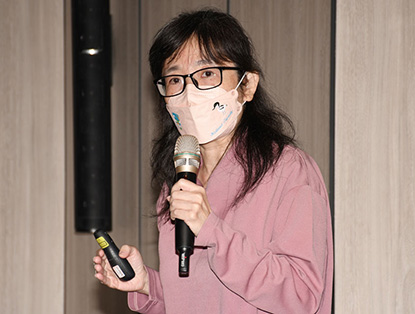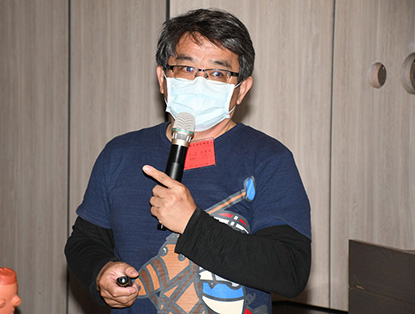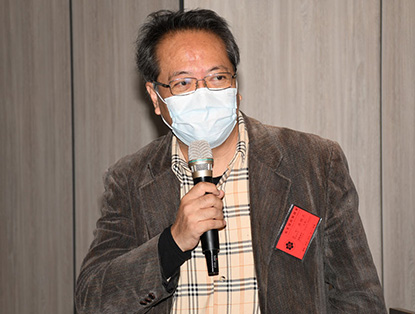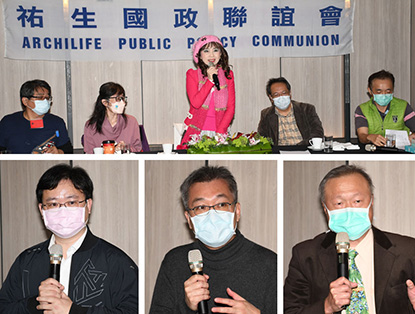Sketch of Public Policy Communion, January 2023Date: 2023-02-21
Section: Activity | 
本會於2023年1月8日假台北晶華酒店四樓寰宇廳舉行「祐生國政聯誼會」。在主持人黃晉英秘書長宣布後揭開當日活動序幕,在輕鬆、活潑的節目之下,隨即由主持人帶來重要訊息:「新冠疫情肆虐三年多來,全球已達6.6億人口確診,近680多萬人病逝,人類生活模式也因此產生改變。此外,烏俄戰爭造成全球政經動盪不安,台海情勢的不穩定狀態也一再被討論,但相信只要台灣人民能夠自立自強,必能度過難關。通貨膨脹、糧食困境、經濟危機皆已浮現,提醒大家注意對自身的影響,祐生生活特組也將討論疫後新世界的因應方案,期望能為人類生存指引新的道路。」
The January Archilife Public Policy Communion of 2023 was held on January 8, 2023. After a series of relaxing and fun activities, Secretary General Huang Chin-ying made the following announcement, "In the three years since the COVID-19 epidemic broke out, 660 million people worldwide have received a confirmed diagnosis, and nearly 6.8 million people have died as a result, drastically altering the way of life. Furthermore, the unstable situation in the Taiwan Strait has been discussed numerous times, and the Ukrainian-Russian War has caused political and economic turmoil on a global scale. There is faith that the Taiwanese people will overcome challenges so long as they have the strength to do so on their own. With the emergence of inflation, the food crisis, and the economic crisis, everyone is reminded to note their impacts on oneself. The Archilife Living Special Team will also discuss the post-pandemic coping plan in an effort to chart a new course for human survival."
 緊接著進行專題演講,由國政委員李君如小姐主講「淨零綠生活‧友你也友我」。主講人首先表示面對氣候變遷的威脅,國家「淨零」的減碳責任,是為了確保人類能永續生存,台灣於2022年4月也調整了氣候變遷因應法,期望擴大公民參與。接著主講人提到台灣2050淨零轉型,除能源、產業、社會外,生活轉型亦為關鍵角色。主講人於2022年8月至10月間辦理「淨零綠生活全民咖啡館」活動,蒐集國內外轉型案例,使全民能共同思考多元做法。而全民綠生活除了食衣住行育樂的推廣,也推動聯合國永續發展目標(SDGs)。主講人表示期望透過更多推廣、採取行動與改變生活方式,使地球更加永續。 緊接著進行專題演講,由國政委員李君如小姐主講「淨零綠生活‧友你也友我」。主講人首先表示面對氣候變遷的威脅,國家「淨零」的減碳責任,是為了確保人類能永續生存,台灣於2022年4月也調整了氣候變遷因應法,期望擴大公民參與。接著主講人提到台灣2050淨零轉型,除能源、產業、社會外,生活轉型亦為關鍵角色。主講人於2022年8月至10月間辦理「淨零綠生活全民咖啡館」活動,蒐集國內外轉型案例,使全民能共同思考多元做法。而全民綠生活除了食衣住行育樂的推廣,也推動聯合國永續發展目標(SDGs)。主講人表示期望透過更多推廣、採取行動與改變生活方式,使地球更加永續。
Next on the schedule was the keynote speech. First, Ms. Li Chun-ju gave a presentation on "Net Zero Green for You and Me". In order to ensure the long-term survival of humanity, the speaker first argued that the threat of climate change necessitates a "net zero" carbon reduction obligation on the part of the country. In addition, Taiwan amended the Climate Change Response Act in April 2022 to encourage more public involvement. The 2050 net-zero transition in Taiwan relies heavily on energy, industry, and society, but it also relies heavily on personal lifestyle change, according to the speaker. The speaker hosted the "The World Cafe" from August to October 2022 in order to compile transformation case studies from around the world for the general public to consider simultaneously. The National Green Life Movement not only promotes food, clothing, housing, transportation, and entertainment, but also the United Nations' sustainable development goals (SDGs). The speaker stated that she desires a more sustainable world brought about by increased advocacy, action, and lifestyle modifications.
 接著由國政委員高傳棋先生主講「馬場町刑場的時空故事」。主講人首先介紹台灣白色恐怖時期的馬場町刑場相關案例,其歷史為:於1945年以前,原為日本陸軍設立之「台北練兵場」,爾後擴建為台北南飛行場,而1949年起,位於堤防外的河灘地,成為槍決政治犯的主要刑場,起迄運作時間約於1949年至1954年。其保存意義與價值,為見證解嚴後受難者團體與後代對於轉型正義真象之追求與努力。主講人表示,馬場町刑場除與其它場域有重要之關連性外,生命權的剝奪是對人權最大的傷害之一,也因此馬場町刑場自有其獨特之重要性。 接著由國政委員高傳棋先生主講「馬場町刑場的時空故事」。主講人首先介紹台灣白色恐怖時期的馬場町刑場相關案例,其歷史為:於1945年以前,原為日本陸軍設立之「台北練兵場」,爾後擴建為台北南飛行場,而1949年起,位於堤防外的河灘地,成為槍決政治犯的主要刑場,起迄運作時間約於1949年至1954年。其保存意義與價值,為見證解嚴後受難者團體與後代對於轉型正義真象之追求與努力。主講人表示,馬場町刑場除與其它場域有重要之關連性外,生命權的剝奪是對人權最大的傷害之一,也因此馬場町刑場自有其獨特之重要性。
Next, Mr. Gao Chuan-chi, spoke on "The Story of Time and Space in the Machangding Execution Ground". The relevant cases of the Machangding Execution Ground during the White Terror period in Taiwan were first introduced by the speaker. He discussed the history of the notorious execution site. Before 1945, the Japanese Army established what they called the "Taipei Training Ground," which later grew into what is now known as the Taipei Airdrome (formerly Taipei SongShan Airport). Located on a river beach outside the embankment, it has since 1949 become the primary execution ground for executing political criminals, which began operations from 1949 to 1954. Its preservation is important and valuable because it will allow us to see how victim groups and future generations endeavor to pursue the truth of transformational justice after martial law has been lifted. The Machangding Execution Ground, according to the speaker, in addition to its ties to other fields. One of the biggest harms to human rights is the denial of the right to life. Therefore, the Machangding Execution Ground has a special significance all of its own.
 接著由國政委員吳綱立先生主講「讓路予風:城市風廊創生」。主講人首先提到城市通風廊道可以減緩熱島效應、改善空氣品質。整體規劃除了要考慮都市建築、植栽,還要研究氣象因素,以數值模擬分析,提供具科學性基礎的城市風廊規劃操作。主講人以台南市為例,表示近二十年溫度呈現上升趨勢,風速呈現下降趨勢,代表熱島強度增加。本案以電腦進行風廊路徑模擬分析,進行更有效率的多尺度城市風廊規劃。主講人最後感性結語,「讓路予風」即讓出更多的空間給自然,給予人類順應氣候的生活模式,讓即是得,讓出擁擠、擴張、高強度,留給下一代氣候更友善的空間。 接著由國政委員吳綱立先生主講「讓路予風:城市風廊創生」。主講人首先提到城市通風廊道可以減緩熱島效應、改善空氣品質。整體規劃除了要考慮都市建築、植栽,還要研究氣象因素,以數值模擬分析,提供具科學性基礎的城市風廊規劃操作。主講人以台南市為例,表示近二十年溫度呈現上升趨勢,風速呈現下降趨勢,代表熱島強度增加。本案以電腦進行風廊路徑模擬分析,進行更有效率的多尺度城市風廊規劃。主講人最後感性結語,「讓路予風」即讓出更多的空間給自然,給予人類順應氣候的生活模式,讓即是得,讓出擁擠、擴張、高強度,留給下一代氣候更友善的空間。
Next, Mr. Wu Gan-li, spoke on "Make Way for the Wind: The Creation of Wind Corridor of City". The speaker first mentioned that the wind corridor of city can reduce the impact of the urban heat island effect and enhance air quality. The overall planning process must be taken account into meteorological factors and use numerical simulation analysis to provide operations for the planning of the wind corridor of city that are based on science, in addition to taking account into urban architecture and landscaping. The speaker cited Tainan City as an example, noting that temperature trends there had been upward for the past 20 years while wind speed had been trending downward, indicating an increase in the intensity of the urban heat island. In order to carry out more effective multi-scale wind corridor of city planning, a computer was used in this instance to simulate and analyze the path of the wind corridor. The speaker concluded on a sentimental note, saying that "making way for the wind" means making room for nature and encouraging a lifestyle that takes account into weather conditions. When one gives up, one gains. If we forego densely populated areas and extremes of intensity and expansion, we can create a more hospitable environment for future generations.
 演講完畢,黃晉英秘書長代表基金會致贈謝禮予主講人。接著在與會者紛紛利用「餵豬時間」提出個人意見與看法交流後,圓滿地結束一月份國政聯誼會。 演講完畢,黃晉英秘書長代表基金會致贈謝禮予主講人。接著在與會者紛紛利用「餵豬時間」提出個人意見與看法交流後,圓滿地結束一月份國政聯誼會。
After the speech, Secretary General Huang Chin-ying presented a gift to the speakers on behalf of the foundation. Then, attendees expressed and exchanged their opinions and views during the piggy hour. The January Archilife Public Policy Communion ended smoothly.
|
|